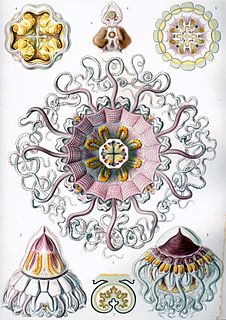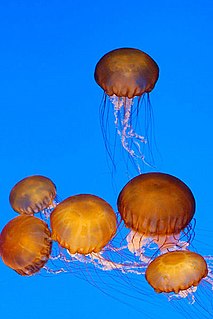
Crown jellyfishes are the six families of true jellyfish that belong to the order Coronatae. They are distinguished from other jellyfish by the presence of a deep groove running around the umbrella, giving them the crown shape from which they take their name. Many of the species in the order inhabit deep sea environments.

Periphyllidae is a family of jellyfish containing four genera and six species. The most well-known member of the family, Periphylla periphylla, is usually considered a deep-sea species, but it forms large blooms in surface waters of Norwegian fjords.

Nausithoidae is a family of jellyfish.

Chrysaora is a genus of jellyfish, commonly called the sea nettles, in the family Pelagiidae. The origin of the genus name Chrysaora lies in Greek mythology with Chrysaor, brother of Pegasus and son of Poseidon and Medusa. Translated, Chrysaor means "he who has a golden armament."

Atolla is a genus of crown jellyfish in the order Coronatae. The genus Atolla was originally proposed by Haeckel in 1880 and elevated to the monotypic family level, as Atollidae by Henry Bigelow in 1913. The six known species inhabit the mesopelagic zone. The medusae possess multiple lobes called lappets at the bell margin. Medusae also have eight tentacles, alternating with eight rhopalia, and twice as many lappets occur as tentacles.
Vanhoffen Bluff is a rocky bluff immediately east of Jacka Glacier on the north coast of Heard Island. It is named for Ernst Vanhöffen (1858–1918), a German zoologist, and a member of the Gauss expedition under the leadership of Erich von Drygalski (1865–1949). During its 1902 investigations of the area, Drygalski applied the name Kap Vanhoffen to a cliffed feature about 1.5 nautical miles (2.8 km) to the northwest, near The Sentinel. The ANARE, during its 1948 survey of the island, transferred the Vanhoffen name to this bluff, reporting that no well-marked cape exists along the high cliffs to the northwest.

Hydractiniidae is a cnidarian family of athecate hydroids.

Ernst Vanhöffen was a German zoologist.
Haliscera is a genus of hydrozoans in the family Halicreatidae.
Haliscera conica is a species of hydrozoan belonging to the family Halicreatidae.
Arctapodema is a genus of deep-sea hydrozoans in the family Rhopalonematidae.
Amphogona is a genus of deep-sea hydrozoans of the family of Rhopalonematidae. It has a cosmopolitan distribution in tropical to temperate oceans.

Rhopalonema is a genus of deep-sea hydrozoans of the family Rhopalonematidae.

Chrysaora chinensis, or the Indonesian sea nettle, is a species of jellyfish in the family Pelagiidae. It is native to the central Indo-Pacific region and its sting is considered dangerous.
Chrysaora africana, the purple compass jelly, is a species of jellyfish from the family Pelagiidae. Found in the southeastern Atlantic Ocean from Gabon to the western coast of South Africa, its taxonomy has historically caused considerable confusion. Like other sea nettles, its sting is painful, but not generally dangerous unless there is an allergic reaction to the venom.

Colobonema sericeum is a species of deep-sea hydrozoan in the family Rhopalonematidae that was first described in 1902. This semi-transparent organism is found in the mesopelagic zone, has 32 tentacles, and has a bell diameter of up 45 mm. They are holoplanktonic and never attach to the seafloor as part of their polyp life cycle, but instead have embryos that develop directly into a small, swimming medusae.

Poralia is a genus of jellyfish in the family Ulmaridae. It is a monotypic genus containing a single species, Poralia rufescens. This jellyfish is pelagic, and is found in deep water in most of the world's oceans.

Corymorpha is a genus of hydrozoans in the family Corymorphidae.

Atorella is a genus of crown jellyfish. It is the only genus in the monotypic family Atorellidae and includes five species. Members of this family are known from the eastern coast of Africa and the western coast of Panama.

Nausithoe is a genus of jellyfishes belonging to the family Nausithoidae.












